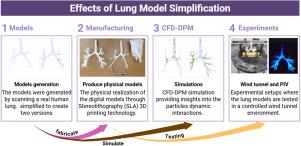评估细支气管简化对呼吸性粉尘沉积的影响:实验与CFD-DPM相结合的分析方法
IF 2.5
3区 工程技术
Q2 MECHANICS
引用次数: 0
摘要
矿工中黑肺病的死灰复燃强调了迫切需要加强我们对呼吸性粉尘沉积机制的理解。本文批判性地评估了在粉尘沉积研究中简化细支气管几何形状的广泛实践,这是一种常用的方法,但往往没有充分考虑其对颗粒壁相互作用和随后的沉积计算的影响。本研究采用粒子图像测速技术(PIV)和专门设计的细支气管复杂模型和简化模型的粉尘风洞,将实验装置与计算模拟相结合,研究了可呼吸性煤尘的行为。此外,本研究在ANSYS Fluent中使用计算流体动力学-离散相模型(CFD-DPM)模拟,结合这些不同的模型来评估几何简化的影响。引入细支气管壁面观测模型,更准确地反映粉尘颗粒与细支气管壁面的动态相互作用,提高了模拟的真实感。与简化模型相比,复杂模型显示了1.5×higher粉尘沉积。这种差异部分归因于其较大的表面积,其表面积比约为1.92。为了提高简化模型的预测能力,提出了基于该比值的修正因子。这种方法不仅揭示了颗粒大小和气道几何形状对粉尘沉积的重要影响,而且对复制这些复杂过程的简化模型的可靠性提出了挑战。这项工作为改善采矿和相关行业的职业健康安全措施提供了宝贵的见解,突出了仔细考虑模式选择及其对环境健康研究的影响的必要性。本文章由计算机程序翻译,如有差异,请以英文原文为准。

Evaluating the effects of bronchioles simplification on respirable dust deposition: A combined experimental and CFD-DPM analysis approach
The resurgence of black lung disease among miners underscores the pressing need to enhance our understanding of respirable dust deposition mechanisms. This paper critically evaluates the widespread practice of simplifying bronchioles geometries in dust deposition studies, a method commonly employed but often without adequate consideration of its impact on particle–wall interactions and subsequent deposition calculations. Through the integration of experimental setups with computational simulations, this study investigates the behavior of respirable coal dust using Particle Image Velocimetry (PIV) and a specially designed dust wind tunnel equipped with both complex and simplified bronchioles models. Further, this research employs Computational Fluid Dynamics-Discrete Phase Model (CFD-DPM) simulations within ANSYS Fluent, incorporating these diverse models to assess the ramifications of geometrical simplification. A bronchioles wall observing model was introduced to enhance the simulation’s realism by more accurately representing the dynamic interactions between dust particles and bronchioles wall surfaces. The complex model showed about 1.5×higher dust deposition compared to the simplified model. This difference was partially attributed to its larger surface area, with a surface area ratio of approximately 1.92. A correction factor based on this ratio was proposed to enhance the predictive capability of simplified models. This approach not only sheds light on the significant influences of particle size and airway geometry on dust deposition but also challenges the reliability of simplified models in replicating these complex processes. This work contributes valuable insights into improving occupational health safety measures in mining and related industries, highlighting the need for careful consideration of model selection and its implications in environmental health research.
求助全文
通过发布文献求助,成功后即可免费获取论文全文。
去求助
来源期刊
CiteScore
5.90
自引率
3.80%
发文量
127
审稿时长
58 days
期刊介绍:
The European Journal of Mechanics - B/Fluids publishes papers in all fields of fluid mechanics. Although investigations in well-established areas are within the scope of the journal, recent developments and innovative ideas are particularly welcome. Theoretical, computational and experimental papers are equally welcome. Mathematical methods, be they deterministic or stochastic, analytical or numerical, will be accepted provided they serve to clarify some identifiable problems in fluid mechanics, and provided the significance of results is explained. Similarly, experimental papers must add physical insight in to the understanding of fluid mechanics.

 求助内容:
求助内容: 应助结果提醒方式:
应助结果提醒方式:


